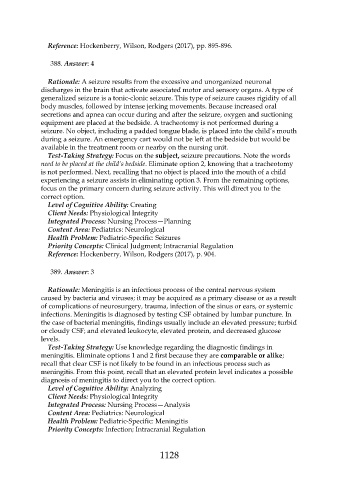Page 1128 - Saunders Comprehensive Review For NCLEX-RN
P. 1128
Reference: Hockenberry, Wilson, Rodgers (2017), pp. 895-896.
388. Answer: 4
Rationale: A seizure results from the excessive and unorganized neuronal
discharges in the brain that activate associated motor and sensory organs. A type of
generalized seizure is a tonic-clonic seizure. This type of seizure causes rigidity of all
body muscles, followed by intense jerking movements. Because increased oral
secretions and apnea can occur during and after the seizure, oxygen and suctioning
equipment are placed at the bedside. A tracheotomy is not performed during a
seizure. No object, including a padded tongue blade, is placed into the child’s mouth
during a seizure. An emergency cart would not be left at the bedside but would be
available in the treatment room or nearby on the nursing unit.
Test-Taking Strategy: Focus on the subject, seizure precautions. Note the words
need to be placed at the child’s bedside. Eliminate option 2, knowing that a tracheotomy
is not performed. Next, recalling that no object is placed into the mouth of a child
experiencing a seizure assists in eliminating option 3. From the remaining options,
focus on the primary concern during seizure activity. This will direct you to the
correct option.
Level of Cognitive Ability: Creating
Client Needs: Physiological Integrity
Integrated Process: Nursing Process—Planning
Content Area: Pediatrics: Neurological
Health Problem: Pediatric-Specific: Seizures
Priority Concepts: Clinical Judgment; Intracranial Regulation
Reference: Hockenberry, Wilson, Rodgers (2017), p. 904.
389. Answer: 3
Rationale: Meningitis is an infectious process of the central nervous system
caused by bacteria and viruses; it may be acquired as a primary disease or as a result
of complications of neurosurgery, trauma, infection of the sinus or ears, or systemic
infections. Meningitis is diagnosed by testing CSF obtained by lumbar puncture. In
the case of bacterial meningitis, findings usually include an elevated pressure; turbid
or cloudy CSF; and elevated leukocyte, elevated protein, and decreased glucose
levels.
Test-Taking Strategy: Use knowledge regarding the diagnostic findings in
meningitis. Eliminate options 1 and 2 first because they are comparable or alike;
recall that clear CSF is not likely to be found in an infectious process such as
meningitis. From this point, recall that an elevated protein level indicates a possible
diagnosis of meningitis to direct you to the correct option.
Level of Cognitive Ability: Analyzing
Client Needs: Physiological Integrity
Integrated Process: Nursing Process—Analysis
Content Area: Pediatrics: Neurological
Health Problem: Pediatric-Specific: Meningitis
Priority Concepts: Infection; Intracranial Regulation
1128

